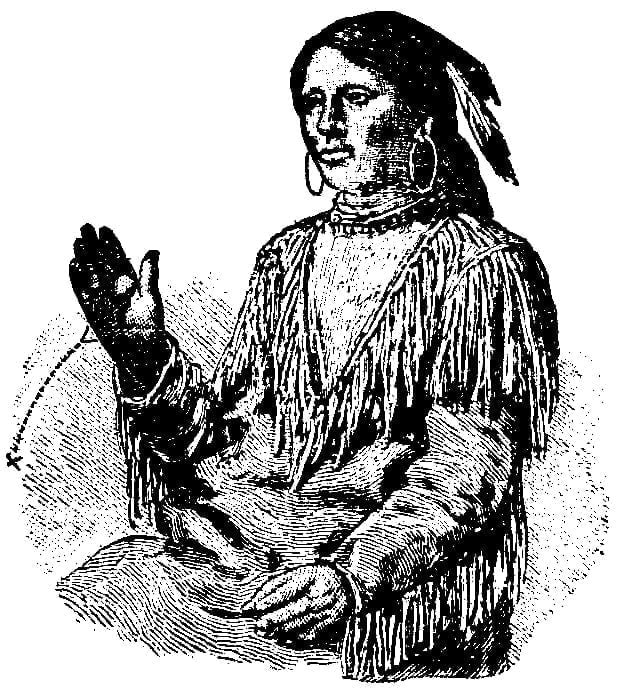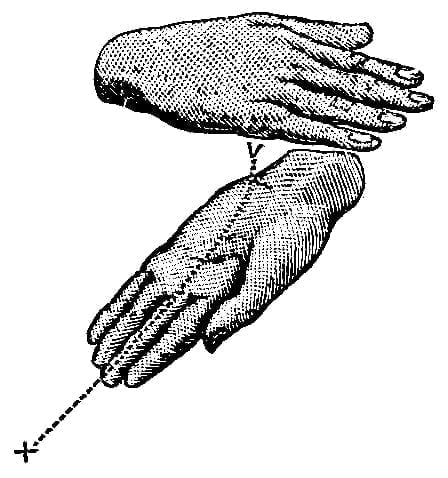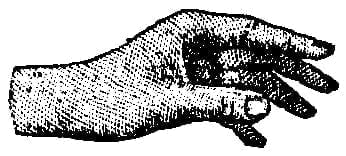No, Not. (Compare Nothing.)
The hand held up before the face, with the palm outward and vibrated to and fro. (Dunbar.)
The right hand waved outward to the right with the thumb upward. (Long; Creel.)
Wave the right hand quickly by and in front of the face toward the right. (Wied.) Refusing to accept the idea or statement presented.
Move the hand from right to left, as if motioning away. This sign also means “I’ll have nothing to do with you.” (Burton.)
A deprecatory wave of the right hand from front to right, fingers extended and joined. (Arapaho I; Cheyenne V.)
Right-hand fingers extended together, side of hand in front of and facing the face, in front of the mouth and waved suddenly to the right. (Cheyenne II.)
Place the right hand extended before the body, fingers pointing upward, palm to the front, then throw the hand outward to the right, and slightly downward. (Absaroka I; Hidatsa I; Arikara I.) See Fig. 65, page 290.
The right hand, horizontal, palm toward the left, is pushed sidewise outward and toward the right from in front of the left breast. No, none, I have none, etc., are all expressed by this sign. Often these Indians for no will simply shake the head to the right and left. This sign, although it may have originally been introduced from the white people’s habit of shaking the head to express “no,” has been in use among them for as long as the oldest people can remember, yet they do not use the variant to express “yes.” (Dakota I.) “Dismissing the idea, etc.”
Place the opened relaxed right hand, pointing toward the left, back forward, in front of the nose or as low as the breast, and throw it forward and outward about eighteen inches. Some at the same time turn the palm upward. Or make the sign at the height of the breast with both hands. Represents the shaking of the head. (Dakota IV.) The shaking of the head in negation is not so universal or “natural” as is popularly supposed, for the ancient Greeks, followed by the modern Turks and rustic Italians, threw the head back, instead of shaking it, for “no.” Rabelais makes Pantagruel (Book 3) show by many quotations from the ancients how the shaking of the head was a frequent if not universal concomitant of oracular utterance—not connected with negation.
Hold the flat hand edgewise, pointing upward before the right side of the chest, then throw it outward and downward to the right. (Dakota VI, VII.) Fig. 270.

The hand, extended or slightly curved, is held in front of the body a little to the right of the median line; it is then carried with a rapid sweep a foot or more farther to the right. (Mandan and Hidatsa I.)
Place the hand as in yes, as follows: The hand open, palm downward, at the level of the breast, is moved forward with a quick downward motion from the wrist, imitating a bow of the head; then move it from side to side. (Iroquois I.) “A shake of the head.”
Throw the flat right hand forward and outward to the right, palm to the front. (Kaiowa I; Comanche III; Apache II; Wichita II.)
Quick motion of open hand from the mouth forward, palm toward the mouth. (Sahaptin I.)
Place hand in front of body, fingers relaxed, palm toward body (Y 1), then with easy motion move to a point, say, a foot from the body, a little to right, fingers same, but palm upward. (Sahaptin I.) “We don’t agree.” To express All gone, use a similar motion with both hands. “Empty.”
The hand waved outward with the thumb upward in a semi-curve. (Comanche I; Wichita I.)
Elevate the extended index and wave it quickly from side to side before the face. This is sometimes accompanied by shaking the head. (Pai-Ute I.) Fig. 271.

Extend the index, holding it vertically before the face, remaining fingers and thumb closed; pass the finger quickly from side to side a foot or so before the face. (Apache I.) This sign, as also that of (Pai-Ute I), is substantially the same as that with the same significance reported from Naples by De Jorio.
Another: The right hand, naturally relaxed, is thrown outward and forward toward the right. (Apache I.)
Wave extended index before the face from side to side. (Apache III.)
Another: Wave the index briskly before the right shoulder. This appears to be more common than the preceding. (Apache III.)
Right hand extended at the height of the eye, palm outward, then moved outward a little toward the right. (Kutchin I.)
Extend the palm of the right hand horizontally a foot from the waist, palm downward, then suddenly throw it half over from the body, as if tossing a chip from the back of the hand. (Wichita I.)
Deaf-mute natural signs:
Shake the head. (Ballard.)
Move both hands from each other, and, at the same time, shake the head. (Hasenstab.)
Deaf-mute signs:
French deaf-mutes wave the hand to the right and downward, with the first and second fingers joined and extended, the other fingers closed. This position of the fingers is that for the letter N in the finger alphabet, the initial for the word non. American deaf-mutes for emphatic negative wave the right hand before the face.
Turkish sign:
Throwing head back or elevating the chin and partly shutting the eyes. This also means, “Be silent.” (Barnum.)
Japanese sign:
Move the right hand rapidly back and forth before the face. Communicated in a letter from Prof. E.S. Morse, late of the University of Tokio, Japan. The same correspondent mentions that the Admiralty Islanders pass the forefinger across the face, striking the nose in passing, for negation. If the no is a doubtful one they rub the nose in passing, a gesture common elsewhere.
For further illustrations and comparisons see pp. 290, 298, 299, 304, 355, and 356, supra.
None, Nothing; I Have None.
Motion of rubbing out. (Macgowan.)
Little or nothing is signified by passing one hand over the other. (Creel; Ojibwa I.)
May be signified by smartly brushing the right hand across the left from the wrist toward the fingers, both hands extended, palms toward each other and fingers joined. (Arapaho I.)
Is included in gone, destroyed. (Dakota I.)
Place the open left hand about a foot in front of the navel, pointing obliquely forward toward the right, palm obliquely upward and backward, and sweep the palm of the open right hand over it and about a foot forward and to the right through a curve. All bare. (Dakota IV.)
Another: Pass the ulnar side of the right index along the left index several times from tip to base, while pronating and supinating the latter. Some roll the right index over on its back as they move it along the left. The hands are to be in front of the navel, backs forward and outward, the left index straight and pointing forward toward the right, the right index straight and pointing forward and toward the left; the other fingers loosely closed. Represents a bush bare of limbs. (Dakota IV.)
Another: With the light hand pointing obliquely forward to the left, the left forward to the right, palms upward, move them alternately several times up and down, each time striking the ends of the fingers. Or, the left hand being in the above position, rub the right palm in a circle on the left two or three times, and then move it forward and to the right. Rubbed out; that is all; it is all gone. (Dakota IV.)
Pass the palm of the flat right hand over the left from the wrist toward and off of the tips of the fingers. (Dakota VI, VII, VIII; Ponka II; Pani I.) Fig. 272.

Brush the palm of the left hand from wrist to finger tips with the palm of the right. (Wyandot I.)
Another: Throw both hands outward toward their respective sides from the breast. (Wyandot I.)
Pass the flat right palm over the palm of the left hand from the wrist forward over the fingers. (Kaiowa I; Comanche III; Apache II; Wichita II.) “Wiped out.”
Hold the left hand open, with the palm upward, at the height of the elbow and before the body; pass the right quickly over the left, palms touching, from the wrist toward the tips of the left, as if brushing off dust. (Apache I.)
Deaf-mute natural signs:
Place the hands near each other, palms downward, and move them over and apart, bringing the palms upward in opposite directions. (Ballard.)
Make a motion as in picking up something between the thumb and finger, carry it to the lips, blow it away, and show the open hand. (Wing.)
Australian sign:
Pannie (none or nothing). For instance, a native says Bomako ingina (give a tomahawk). I reply by shaking the hand, thumb, and all fingers, separated and loosely extended, palm down. (Smyth, loc. cit.) Fig. 273.

Blowing across open palm as though blowing off feathers; also means “Nothing, nothing left.” (Barnum.)
- -, I have none.
Deaf-mute natural signs:
Expressed by the signs for none, after pointing to one’s self. (Ballard.)
Stretch the tongue and move it to and fro like a pendulum, then shake the head as if to say “no.” (Ziegler.)
- – Left. Exhausted for the present.
Hold both hands naturally relaxed nearly at arm’s length before the body, palms toward the face, move them alternately to and fro a few inches, allowing the fingers to strike those of the opposite hand each time as far as the second joint. (Kaiowa I; Comanche III; Apache II; Wichita II.) Cleaned out.
